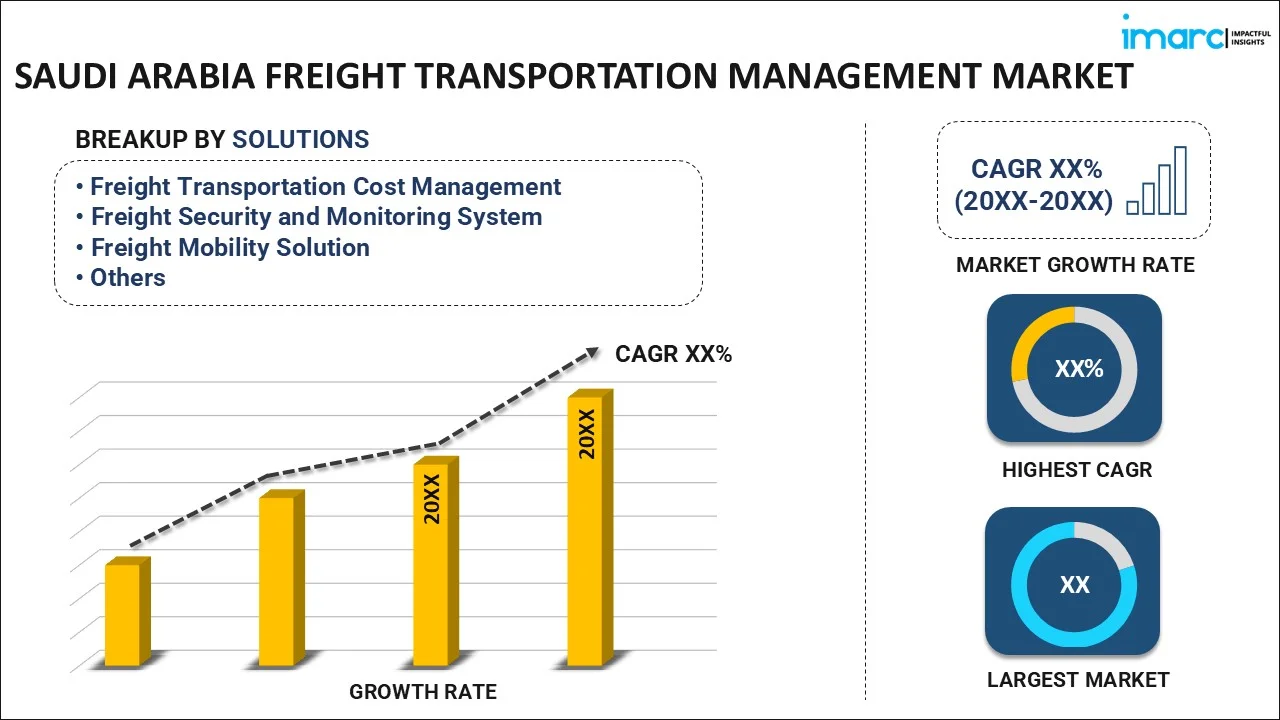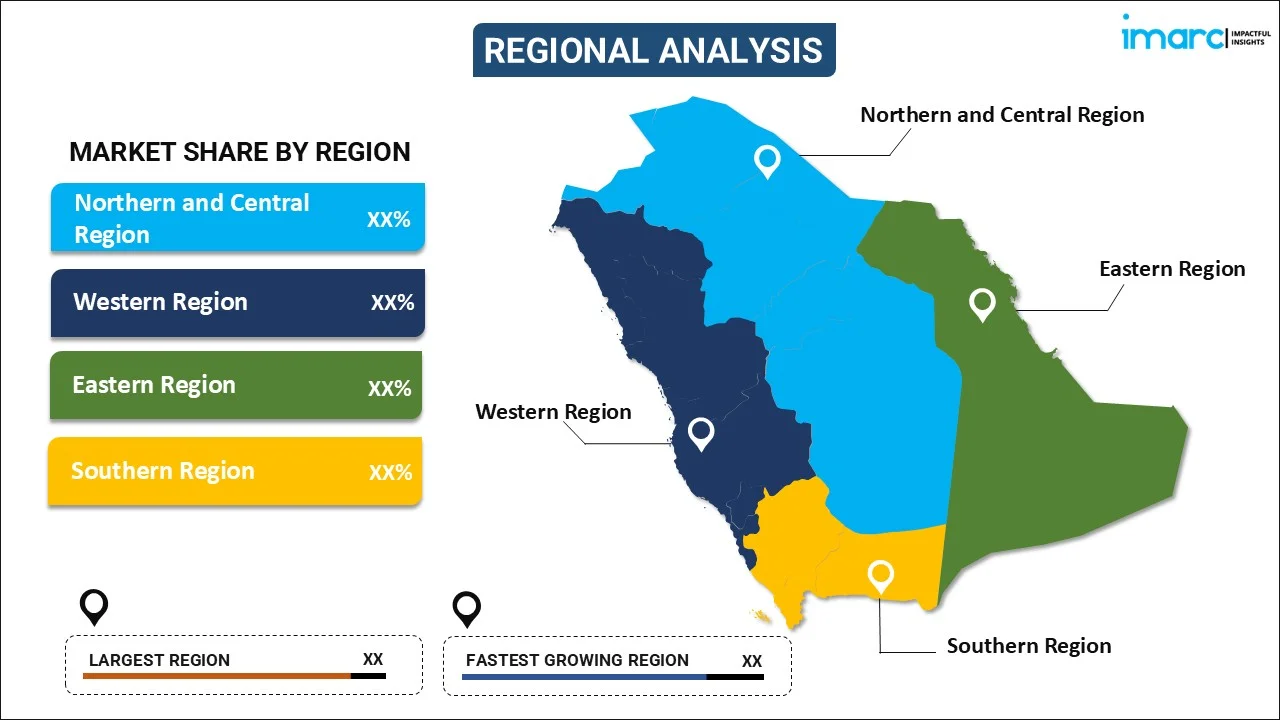
Saudi Arabia Freight Transportation Management Market Size, Share, Trends and Forecast by Solution, Deployment, Mode of Transport, End User, and Region, 2025-2033
Saudi Arabia Freight Transportation Management Market Overview:
The Saudi Arabia freight transportation management market size reached USD 0.16 Billion in 2024. Looking forward, IMARC Group expects the market to reach USD 0.40 Billion by 2033, exhibiting a growth rate (CAGR) of 8.70% during 2025-2033. The market is driven by an increasing demand for efficient logistics, infrastructure development, e-commerce expansion, government investments in transport, supply chain optimization, technological advancements, and regional trade growth.
|
Report Attribute
|
Key Statistics
|
|---|---|
|
Base Year
|
2024 |
|
Forecast Years
|
2025-2033
|
|
Historical Years
|
2019-2024
|
| Market Size in 2024 | USD 0.16 Billion |
| Market Forecast in 2033 | USD 0.40 Billion |
| Market Growth Rate (2025-2033) | 8.70% |
Saudi Arabia Freight Transportation Management Market Trends:
E-commerce growth and demand for efficient logistics
The rise of e-commerce in Saudi Arabia has significantly impacted freight transportation management. For instance, as per industry reports, e-commerce industry in Middle East was evaluated at USD 1.80 Billion in 2024, exhibiting growth increment by 30%, with Saudi Arabia emerging as one of the top growth contributors. In addition to this, online orders elevated by 9% in Saudi during the same year. This growing demand for online shopping has resulted in an escalation in the volume of small and fast-moving goods. In order to cater to the growing need for quick and dependable delivery, logistics providers are currently adopting freight transportation management systems that offer real-time tracking, route optimization, and faster response times. These systems enable companies to manage complex logistics requirements, ensure timely deliveries, and enhance customer satisfaction. The shift towards e-commerce has also pushed businesses to streamline their supply chains and adopt more flexible and scalable logistics solutions, boosting the demand for advanced freight management technologies that can handle high order volumes efficiently.
Infrastructure development and investment
Saudi Arabia is undergoing substantial infrastructure development, particularly in transportation networks such as roads, ports, and airports. The Saudi Vision 2030 initiative emphasizes diversifying the economy, which includes substantial investments in logistics and transport infrastructure. For instance, as per industry reports, Saudi Arabia is actively striving to establish itself as a major hub for logistics amongst the Gulf nations, under its key initiative Vision 2030. Chief targets include the capacity expansion for sea freight and construction of a railway network for multi-model connectivity by the year 2030, along with air cargo capacity increase by above 4.5 Million Tons annually. Moreover, the government has allocated significant funds to modernize and expand critical transportation hubs, enhancing freight movement efficiency. Projects like the King Abdulaziz Port in Jeddah and the King Khalid International Airport in Riyadh are pivotal in increasing the capacity for cargo handling. This improved infrastructure provides better connectivity within the country and to global markets, facilitating the growth of freight transportation management systems (TMS). As the infrastructure continues to evolve, logistics companies are integrating advanced TMS solutions to optimize routes, manage supply chains, and reduce operational costs, further driving market growth.
Saudi Arabia Freight Transportation Management Market Segmentation:
IMARC Group provides an analysis of the key trends in each segment of the market, along with forecasts at the country level for 2025-2033. Our report has categorized the market based on solution, deployment, mode of transport, and end user.
Solution Insights:

- Freight Transportation Cost Management
- Freight Security and Monitoring System
- Freight Mobility Solution
- Warehouse Management System
- Freight 3PL Solutions
- Others
The report has provided a detailed breakup and analysis of the market based on the solution. This includes freight transportation cost management, Freight Security and Monitoring System, Freight Mobility Solution, Warehouse Management System, Freight 3PL Solutions, and others.
Deployment Insights:
- Cloud
- On-premise
A detailed breakup and analysis of the market based on the deployment have also been provided in the report. This includes Cloud and on-premise.
Mode of Transport Insights:
- Rail Freight
- Road Freight
- Waterborne Freight
- Air Freight
A detailed breakup and analysis of the market based on the mode of transport have also been provided in the report. This includes rail freight, road freight, waterborne freight, and air frieght.
End User Insights:
- Aerospace and Defense
- Automotive
- Oil and Gas
- Consumer and Retail
- Energy and Power
- Others
A detailed breakup and analysis of the market based on the end user have also been provided in the report. This includes aerospace and defense, automotive, oil and gas, consumer and retail, energy and power, and others.
Regional Insights:

- Northern and Central Region
- Western Region
- Eastern Region
- Southern Region
The report has also provided a comprehensive analysis of all the major regional markets, which include Northern and Central Region, Western Region, Eastern Region, and Southern Region.
Competitive Landscape:
The market research report has also provided a comprehensive analysis of the competitive landscape. Competitive analysis such as market structure, key player positioning, top winning strategies, competitive dashboard, and company evaluation quadrant has been covered in the report. Also, detailed profiles of all major companies have been provided.
Saudi Arabia Freight Transportation Management Market News:
- In October 2023, Moventis proliferated its intercity transportation services for Saudi Arabia, connecting major 60 cities. The company worked in alliance with a major partner in Saudi Arabia and introduced a new fleet of buses with leading-edge technology, encompassing a analytic system for route upgrading and the Mobileye Accident Detection system.
- In August 2024, J&T Express launched J&T SPEED in Saudi Arabia, aiming to provide dependable, convenient, and effective parcel delivery services for individual customers and businesses. The service, which utilizes J&T Express's resilient logistics network and operational expertise, offers an average delivery time of only 58 hours, with delivery from Riyadh to Jeddah taking as little as 20 hours.
Saudi Arabia Freight Transportation Management Market Report Coverage:
| Report Features | Details |
|---|---|
| Base Year of the Analysis | 2024 |
| Historical Period | 2019-2024 |
| Forecast Period | 2025-2033 |
| Units | Billion USD |
| Scope of the Report |
Exploration of Historical Trends and Market Outlook, Industry Catalysts and Challenges, Segment-Wise Historical and Future Market Assessment:
|
| Solutions Covered | Freight Transportation Cost Management, Freight Security and Monitoring System, Freight Mobility Solution, Warehouse Management System, Freight 3PL Solutions, Others |
| Deployments Covered | Cloud, On-premise |
| Mode of Transports Covered | Rail Freight, Road Freight, Waterborne Freight, Air Freight |
| End Users Covered | Aerospace and Defense, Automotive, Oil and Gas, Consumer and Retail, Energy and Power, Others |
| Regions Covered | Northern and Central Region, Western Region, Eastern Region, Southern Region |
| Customization Scope | 10% Free Customization |
| Post-Sale Analyst Support | 10-12 Weeks |
| Delivery Format | PDF and Excel through Email (We can also provide the editable version of the report in PPT/Word format on special request) |
Key Questions Answered in This Report:
- How has the Saudi Arabia freight transportation management market performed so far and how will it perform in the coming years?
- What is the breakup of the Saudi Arabia freight transportation management market on the basis of solution?
- What is the breakup of the Saudi Arabia freight transportation management market on the basis of deployment?
- What is the breakup of the Saudi Arabia freight transportation management market on the basis of mode of transport?
- What is the breakup of the Saudi Arabia freight transportation management market on the basis of end user?
- What is the breakup of the Saudi Arabia freight transportation management market on the basis of region?
- What are the various stages in the value chain of the Saudi Arabia freight transportation management market?
- What are the key driving factors and challenges in the Saudi Arabia freight transportation management market?
- What is the structure of the Saudi Arabia freight transportation management market and who are the key players?
- What is the degree of competition in the Saudi Arabia freight transportation management market?
Key Benefits for Stakeholders:
- IMARC’s industry report offers a comprehensive quantitative analysis of various market segments, historical and current market trends, market forecasts, and dynamics of the Saudi Arabia freight transportation management market from 2019-2033.
- The research report provides the latest information on the market drivers, challenges, and opportunities in the Saudi Arabia freight transportation management market.
- Porter's five forces analysis assist stakeholders in assessing the impact of new entrants, competitive rivalry, supplier power, buyer power, and the threat of substitution. It helps stakeholders to analyze the level of competition within the Saudi Arabia freight transportation management industry and its attractiveness.
- Competitive landscape allows stakeholders to understand their competitive environment and provides an insight into the current positions of key players in the market.
Need more help?
- Speak to our experienced analysts for insights on the current market scenarios.
- Include additional segments and countries to customize the report as per your requirement.
- Gain an unparalleled competitive advantage in your domain by understanding how to utilize the report and positively impacting your operations and revenue.
- For further assistance, please connect with our analysts.
 Inquire Before Buying
Inquire Before Buying
 Speak to an Analyst
Speak to an Analyst
 Request Brochure
Request Brochure
 Request Customization
Request Customization




.webp)




.webp)












